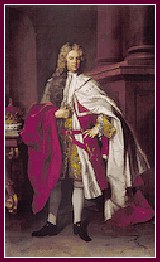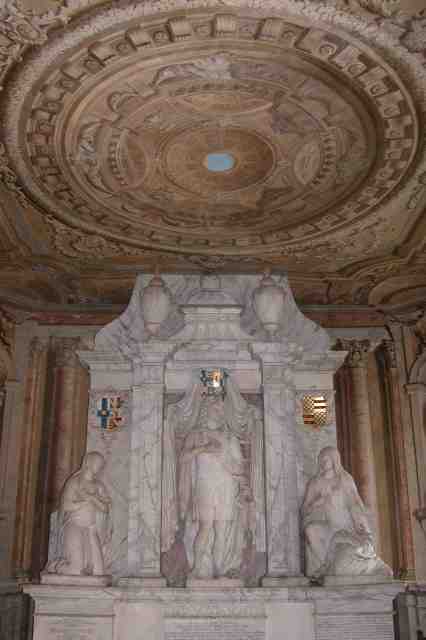| |
 |
The rise and fall of Henry James Brydges, first
duke of Chandos, provides as worthy a subject as any for a film or television
drama. Within the space of ten years, from say 1710 to 1720, he rose to
fame and riches, only to descend into relative obscurity following the loss
of his wealth which was equally as dramatic as the gaining of it. Along
the way he created one of baroque London's most palatial mansions, and was
responsible for bequeathing to posterity the inestimable gift of Handel's
Chandos Anthems.
Born in 1673 the son of a Herefordshire squire, in 1696 he married his
cousin, Mary Lake (c.1666-1712), who brought to the marriage the manor
known as Cannons as part of her dowry. Two years after his marriage to
Mary Lake, Brydges became Member of Parliament for Hereford. He rose by
force of personality, administrative ability and the favor of the Duke
of Marlborough to become Paymaster of the Forces Abroad during the War
of the Spanish Succession. The Paymaster was able to speculate with the
monies he received, and by the time he left the post in 1713 Brydges had
accumulated a fortune estimated at £600,000, a sum having in the
year 1713 the same purchasing power as £58 million, or $95 million
today.
|
| His first wife, Mary died in 1712,
and in 1713 Brydges married his 43 year-old first cousin, Cassandra Willoughby
(1670-1735). Kneller's family portrait, which is signed and dated 1713,
shows Brydges with his second wife, Cassandra. At about this time he began
the enlargement of Cannons, remodeling the Jacobean mansion in the Georgian
Baroque style. In 1714 the couple and Brydges' two sons (the only surviving
children from nine born to him and Mary) moved into the first completed
part of their enlarged and now palatial home. In October 1714 Brydges inherited
the earldom of Caernarvon, which had recently been bestowed on his ailing
father. It was about this time that Chandos, who would also build a very
fine private chapel at Canons, set about the rebuilding of the Church of
St Lawrence (Whitchurch) at Little Stanmore, in a hugely confident and fashionable
(in Europe!) Continental Baroque style. Provision for his earthly remains
was obviously a personal priority, as can be seen from the picture to the
right.
In 1717 Brydges was created first Duke of Chandos 'for no apparent reason',
and in the same year on August 4th, he secured the services of G. F. Handel
who joined the Chapelmaster Dr. Pepusch as composer-in-residence. The
Duke maintained an excellent musical establishment of up to thirty first-class
players among whom were named Francesco Scarlatti, brother of Alessandro,
and Johann Christoph Bach, cousin of J.S.
His wealth and opulence would not long outlast him, as he (along with
many rich noblemen of the day) lost a large proportion of his wealth to
the South Seas Company speculative bubble. On his death, Canons was demolished
for the auction of its parts. Fortunately, St Lawrence's did not suffer
the same fate.
|
|
|
|
 |
|
|
|
|
|
|
|
|